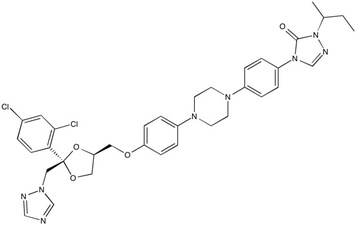Itraconazole | Autophagy inducer / Inhibits glioblastoma growth
NMR (Conforms)

Available Options
| Size : | Price | Quantity | |
|---|---|---|---|
| 50 mg | $45.00 | ||
| 250 mg | $180.00 |
Itraconazole (84625-61-6) inhibits the conversion of lanosterol to ergosterol via inhibition of the 14-α demethylase, a cytochrome P-450 enzyme.1 Clinically useful antifungal agent. It inhibits the proliferation of glioblastoma cells in vitro and in vivo by inducing autophagic progression via inhibiting the trafficking of cholesterol from late endosomes and lysosomes to the plasma membrane.2 Inhibits the hedgehog pathway by binding to Smoothened (SMO) via a mechanism distinct from that of cyclopamine.3 Inhibits angiogenesis via inhibiting the binding of VEGF to VEGFR2.4
References/Citations:
1) Vanden Bossche et al. (1993), Effects of itraconazole on cytochrome P-450-dependent sterol 14 alpha-demethylation and reduction of 3-ketosteroids in Cryptococcus neoformans; Antimicrob. Agents Chemother., 37 2101
2) Liu et al. (2014), Itraconazole suppresses the growth of glioblastoma through induction of autophagy: involvement of abnormal cholesterol trafficking; Autophagy, 10 1241
3) Kim et al. (2010), Itraconazole, a commonly used antifungal that inhibits Hedgehog pathway activity and cancer growth; Cancer Cell, 17 388
4) Nacev et al. (2011), The antifungal drug itraconazole inhibits vascular endothelial growth factor receptor 2 (VEGFR2) glycosylation, trafficking, and signaling in endothelial cells; J. Biol. Chem., 286 44045
NMR (Conforms)
Safety Data Sheet:
Product Data Sheet:
Materials provided by Focus Biomolecules are for laboratory research use only and are not intended for human or veterinary applications. Please note that we do not sell to individuals and that all orders placed by non-research organizations will incur a $20 restocking/refund fee
Itraconazole (84625-61-6) inhibits the conversion of lanosterol to ergosterol via inhibition of the 14-α demethylase, a cytochrome P-450 enzyme.1 Clinically useful antifungal agent. It inhibits the proliferation of glioblastoma cells in vitro and in vivo by inducing autophagic progression via inhibiting the trafficking of cholesterol from late endosomes and lysosomes to the plasma membrane.2 Inhibits the hedgehog pathway by binding to Smoothened (SMO) via a mechanism distinct from that of cyclopamine.3 Inhibits angiogenesis via inhibiting the binding of VEGF to VEGFR2.4
References/Citations:
1) Vanden Bossche et al. (1993), Effects of itraconazole on cytochrome P-450-dependent sterol 14 alpha-demethylation and reduction of 3-ketosteroids in Cryptococcus neoformans; Antimicrob. Agents Chemother., 37 2101
2) Liu et al. (2014), Itraconazole suppresses the growth of glioblastoma through induction of autophagy: involvement of abnormal cholesterol trafficking; Autophagy, 10 1241
3) Kim et al. (2010), Itraconazole, a commonly used antifungal that inhibits Hedgehog pathway activity and cancer growth; Cancer Cell, 17 388
4) Nacev et al. (2011), The antifungal drug itraconazole inhibits vascular endothelial growth factor receptor 2 (VEGFR2) glycosylation, trafficking, and signaling in endothelial cells; J. Biol. Chem., 286 44045
Related Autophagy Modulators
Download
Calculate the molar concentration, mass or volume in a solution.
Concentration × Volume × Molecular Weight = Mass
Focus Biomolecules • Plymouth Meeting, PA USA • 1-855-FOCUS21
Focus Biomolecules
Plymouth Meeting, PA USA
1-855-FOCUS21
Website Created by Advanta Advertising LLC.

